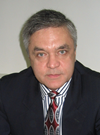
Sergey Suchkov
I.M.Sechenov First Moscow State Medical University, Russia
Title: Translational ideology and armamentarium as a strategic tool for advancing T1D-related care: Fundamental, applied and affiliated issues
Biography
Biography: Sergey Suchkov
Abstract
Type One diabetes (T1D) whilst being a chronic disease, the defining feature of which is the destruction of the insulin-secreting beta-cells and subsequent dependence on exogenous insulin, is possessing with hallmark characteristics of the complex T cell-mediated autoimmunity superimposed on genetic susceptibility. Both genetic and environmental factors combine to precipitate disease, and the outcome of the pathological process is dependent on multiple interrelated factors. The annual global incidence of T1D is increasing by 3-5% per year. Both HLA-genes and immune markers (autoantibodies/autoAbs) have been validated as predictive biomarkers of the subsequent development of the disease in higher-risk relatives and the lower-risk general population. Over the last three decades whilst securing translation of the outcome of basic research in the daily clinical practice using a combination of genomic, proteomic, and metabolomic biomarkers, clinicians are now able to quantify an individual's disease risk from 1 in 100,000 to more than 1 in 2. The HLA genes are reported to account for approximately 40-50% of the familial aggregation of T1D. Current approaches for the prediction of T1D in screening studies take advantage of genotyping HLA-DR and HLA-DQ loci, which is then combined with family history and screening for autoAbs directed against islet-cell antigens. Inclusion of additional moderate HLA risk haplotypes may help identify the majority of children withT1D before the onset of the disease. Fine mapping and functional studies are gradually revealing the complex mechanisms whereby immune self-tolerance is lost, involving multiple aspects of adaptive immunity. The triggering of these events by dysregulation of the innate immune system has also been implicated by genetic evidence. Finally, genetic prediction of T1D risk is showing promise of use for preventives trategies. Understanding of the genetics, environmental factors, and natural history of T1D has led to greater understanding of the etiology and epidemiology of T1D. Accurate prediction is vital for disease prevention so that therapy can be given to those individuals who are most likely to develop the disease. The utility of predictive markers is dependent on three parameters, which must be carefully assessed: sensitivity, specificity and positive predictive value. Specificity is important if a biomarker is to be used to identify individuals either for counseling or for preventive therapy. However, a reciprocal relationship exists between sensitivity and specificity. Thus, successful biomarkers will be highly specific without sacrificing sensitivity. Antiislet autoAbs can be detected before and at time of clinical diagnosis of disease. Autoantibodies (autoAbs) to beta cell antigens (Ags) are used in the diagnosis of T1D, and studies have shown that they can be used to predict risk of developing T1D in first degree relatives of probands. Strategies for disease intervention, therefore, will not only require the induction of T-cell tolerance by tipping the balance towards regulation but will also need to contain approaches that result in the scavenging of inflammatory mediators, in order to facilitate repair. FoxP3-expressing CD4(+) regulatory T cells (Tregs) are potential candidates to control autoimmunity because they play a central role in maintaining self-tolerance. Ultimately, given that clinical diabetes presents late in the autoimmune process, strategies for β-cell regeneration must now be addressed as well. The optimal therapeutic approach for T1D should ideally preserve the remaining β-cells, restore β-cell function, and protect the replaced insulin-producing cells from autoimmunity. SCs possess immunological and regenerative properties that could be harnessed to improve the treatment of T1D; indeed, SCs may reestablish peripheral tolerance toward β-cells through reshaping of the immune response and inhibition of autoreactive T-cell function. There is thus a requirement for an increased, collaborative effort between stem cell biologists and immunologists in order to tailor an optimal therapeutic strategy for the treatment of this debilitating disease whilst translating the basic outcome into the daily clinical practice. There is an immediate need to restore both β-cell function and immune tolerance to control disease progression and ultimately cure T1D.
